23+ Most Extreme Horror Movies from Japan
Gore, cruelty, sex, and more, all blended together and taken to grueling extremes. Welcome to the world of Japanese shock cinema.
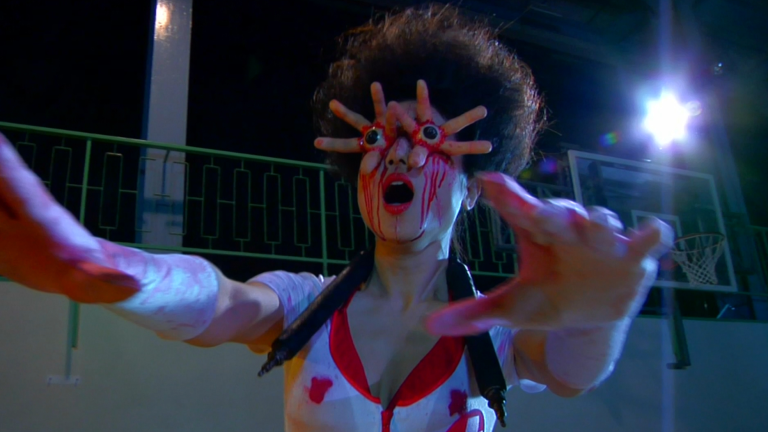
Table of Contents
Japan has a reputation for producing some of the most extreme horror movies ever made. Considering the steady stream of notoriously shocking and transgressive movies coming out of Japan for decades, their reputation is well-deserved.

Horror movies in post-war Japan generally fell into two categories: ghost stories adapted from folklore, or science-fiction often featuring a giant monster. Then, in the 60s and 70s, movies such as Teruo Ishii’s violent and erotic Shogun’s Joy of Torture (1968) and Kinji Fukasaku’s bloody crime epic Battles Without Honor and Humanity (1973) increasingly pushed against the boundaries of what was acceptable to show in movie theaters. However, home video is where the true extremes of Japanese movies were explored.
Japan took advantage of the expansion of VHS into homes by producing cheaply-made movies that relied heavily on gratuitous sex, excessive gore, and increasingly disturbing scenarios. The trend lasted throughout the 80s and 90s and produced some of the world’s most notorious examples of extreme cinema. Eventually, extreme became mainstream with directors like Takashi Miike. Then, in the 2000s, a new wave of excessively violent horror emerged with action/horror hybrids like Meatball Machine (2005).

This list collects some of the best examples of extreme Japanese horror, focusing on movies released from the 1980s until today. For this list, “extreme” is defined as not just a movie containing a lot of blood and/or sex, but as a movie that also pushes taboo subjects to extremes.
Classic Extreme Japanese Horror • 1985 – 2001
Guinea Pig Series (1985 – 1989)
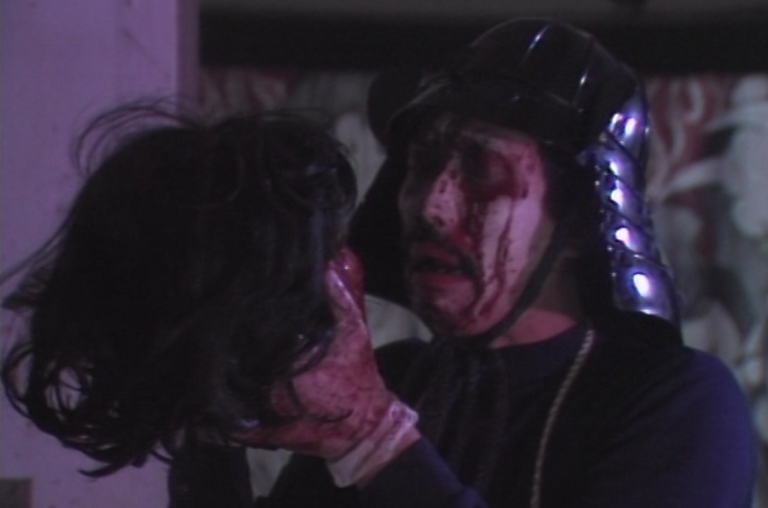
The Guinea Pig movies are a collection of six direct-to-video splatter movies that became notorious around the world. Each entry is a standalone experience, and the tone of the series varies wildly. However, the one overarching theme, and the thing the series is most known for, is the extreme amount of gore. The movies were difficult to obtain for decades (and are still expensive to buy online), and the scarcity of the movies combined with their blood and gore helped elevate the Guinea Pig series to an almost mythical status for horror fans around the world.

- Devil’s Experiment (1985) – Shot almost like a found-footage movie, a woman suffers various types of torture.
- Flower of Flesh and Blood (1985) – A woman is kidnapped, drugged, and dismembered by a man wearing a samurai helmet in this faux snuff film.
- He Never Dies (1986) – A comedy about an office worker who tries to commit suicide, only to find that no amount of dismemberment can kill him.
- Devil Woman Doctor (1986) – A goofy comedy about a doctor who sees various patients with gory problems.
- Mermaid in the Manhole (1988) – An artist finds a mermaid who is dying of a horribly gruesome condition.
- Android of Notre Dame (1989) – A scientist needs bodies to experiment on so he can cure his sister’s illness.
Entrails of a Beautiful Woman (1986)
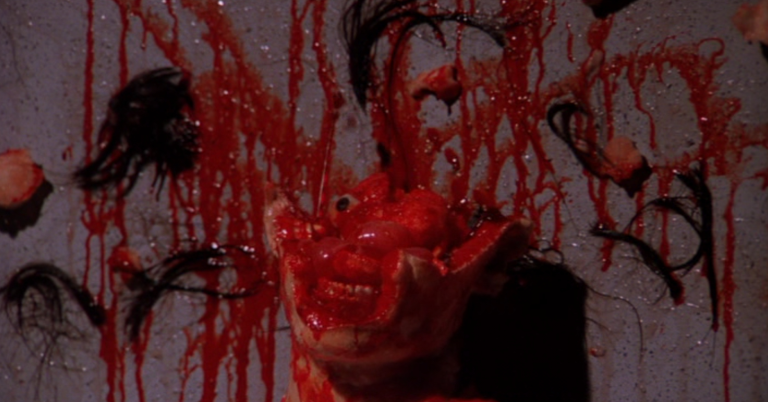
From director Kazuo Komizu, Entrails of a Beautiful Woman combines softcore porn with a bizarre and gory monster movie. The story follows a doctor who tries to take revenge on behalf of her patient who is driven to suicide after being raped by Yakuza gangsters. The first half of the movie features numerous scenes of sex and sexual assault, but once the plan for revenge goes sideways, the craziness increases considerably. Bodies are chopped to pieces, heads explode, and a gooey red monster does some truly horrible things to some truly horrible people.
Tetsuo: The Iron Man (1989)
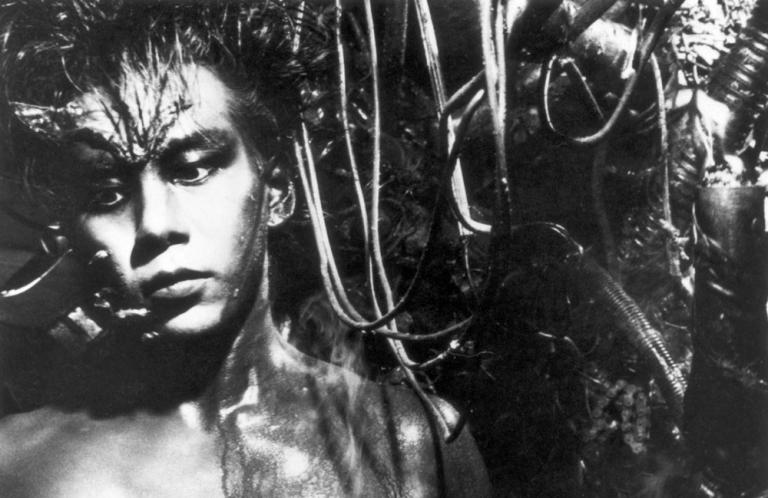
Tetsuo: The Iron Man is an unrelenting experience of twisted body horror from iconic Japanese filmmaker Shinya Tsukamoto. The movie is about a normal businessman who is horrified by his gradual transformation into a bio-mechanical monstrosity. The wild transformations are accomplished through various practical methods including stop-motion animation which gives the movie an incredibly raw appearance even decades after it was first released. Phallic imagery abounds in Tetsuo (something Shinya Tsukamoto is known for), and that combined with ultra-violence and insane imagery helped establish Tetsuo as a classic of extreme cinema.
All Night Long Series (1992 – 2009)
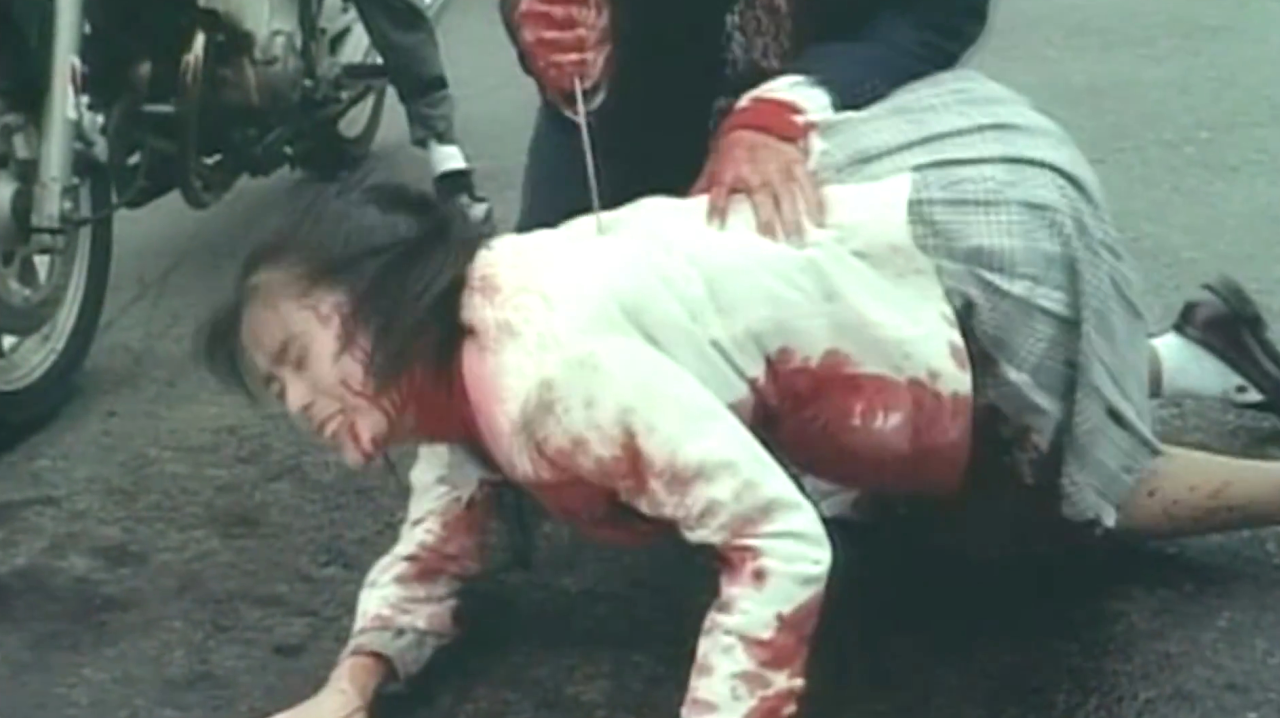
All Night Long (or Ooru Naito Rongu in its Japanese pronunciation) is a series of disturbing movies that deal with violent youth. The stories are not connected, but they contain themes of bullying, revenge, obsession, frustration, and a fascination with bloody violence. The All Night Long movies are likely a reaction to the spike in youth-oriented crime (and the environment that fed into it) in Japan that started in the1980s and continued into the 1990s. High-profile murders committed by teens against other teens provided a real-life counterpart to the horrific nature of the All Night Long movies.
Splatter: Naked Blood (1996)
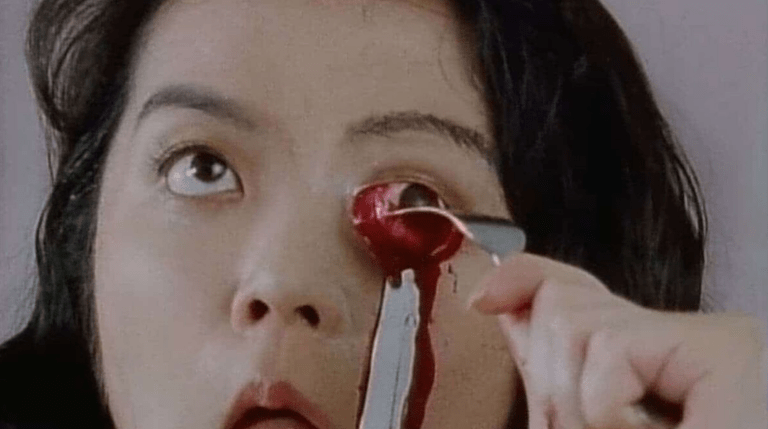
A drug created by a teenage scientist provides the catalyst for body horror in Splatter: Naked Blood. A teen boy named Eiji (Sadao Abe) develops a chemical he calls “MySon” which turns pain into pleasure. Eiji secretly uses MySon on three women taking part in a clinical trial for a contraceptive, but his secret experiment doesn’t go well. Two of the women engage in horrific self-mutilation, with one of the women performing multiple piercings all over her body, and the other woman cooking and eating parts of her own body. The third woman, Rika (Misa Aika), begins to get pleasure from the suffering of others, including Eiji.
Organ (1996)
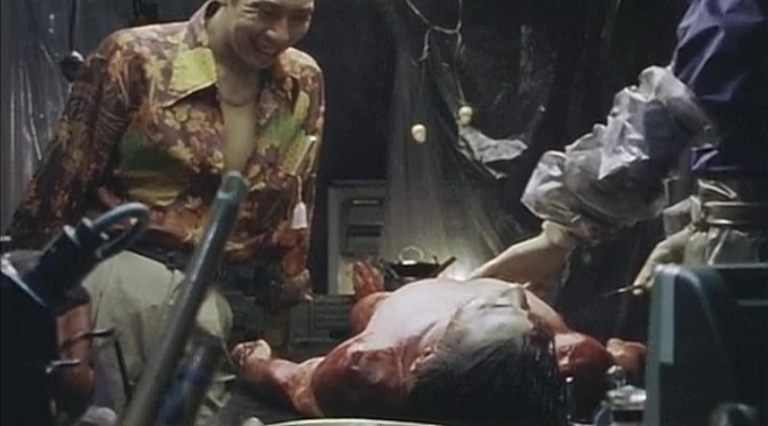
Stomach-turning body horror, gore, sexual violence, and a strong sense of the bizarre make Organ a gem of 1990s extreme horror. The movie begins with police detectives attempting to track down a gang of yakuza who specialize black market organ dealing. Organ shifts focus after a while, focusing more on the gang and their demented doctor who performs disgusting experiments on people. The meandering plot of Organ is far from the most coherent thing on this list, but what the movie lacks in sense, it makes up for in gore and violence.
Kichiku: Banquet of the Beasts (1997)

Kichiku: Banquet of the Beasts is a movie that builds up to a particularly cruel and gory climax. Set in the 1970s, a group of students with political extremist leanings await their leader’s release from prison. In the meantime, the leader’s girlfriend has taken over, but, lacking the group’s respect, she loses control when news of the leader’s suicide reaches the group. This leads to a series of ultra-violent scenes where the gang falls apart in a graphic display of carnage that involves everything from genital mutilation to a head blown away from the eyes up.
Tumbling Doll of Flesh (1998)
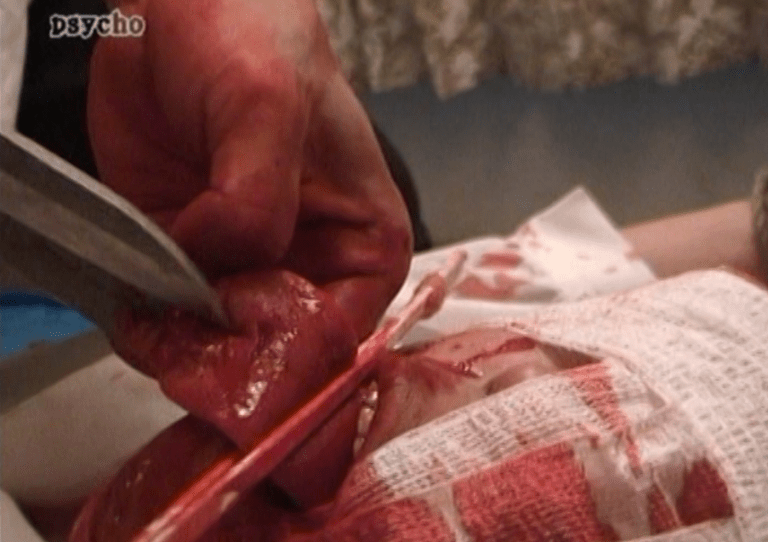
Shot on fuzzy video and adhering mostly to a found-footage format, Tumbling Doll of Flesh is presented as behind-the-scenes footage of a pornographic snuff film. The first half of the movie shows a director and cameraman as they convince their male and female actors to engage in various sexual acts, but the proceedings take a violent turn when the woman tries to leave. The woman is then tied to a bed where she stabbed, eviscerated, and dismembered in front of the camera. The gore effects aren’t always convincing, but there are plenty of shots that are convincing enough to give viewers a truly unpleasant experience.
Red Room (1999)
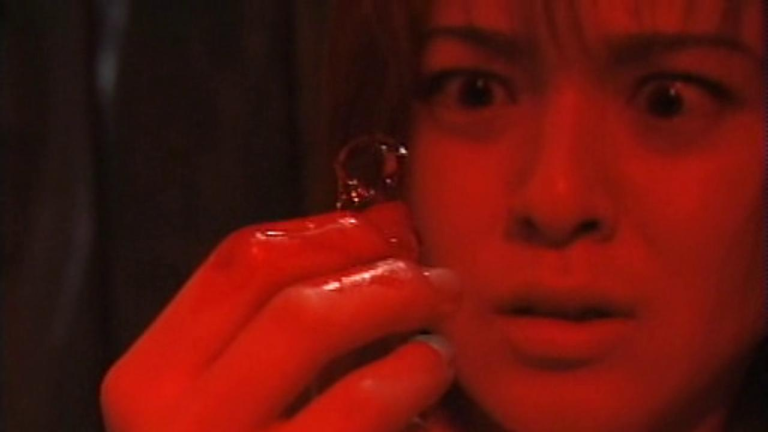
Directed by Daisuke Yamanouchi, Red Room is about four seemingly normal people who volunteer for a game in which the winner receives enough money to change their life. At the start of each round, the players draw cards which randomly assigns a “king.” The king gets to make up a dare that the other players must perform. If they fail to complete the dare for any reason, they are eliminated, and the game continues until only one person is left. The dares start off rather tame, but by the end of the game the players are forcing each other into grotesque situations largely based on sexual violence. Red Room led to a sequel, Red Room 2, in 2000.
Girl Hell 1999 (1999)

Girl Hell 1999 is all about high school girl Misaki as she endures a horrific few days. All the men surrounding Misaki in her daily life are violent sexual deviants, the worst being her own father who repeatedly rapes and tortures Misaki’s sister. Misaki’s only friends are a schoolgirl prostitute who doesn’t care much for Misaki, and a disturbed homeless woman who treats a doll as her real child (even breastfeeding it at one point). Girl Hell 1999 is bleak, violent, and gross, though its extremes may come across as being more ridiculous than disturbing.
Audition (1999)
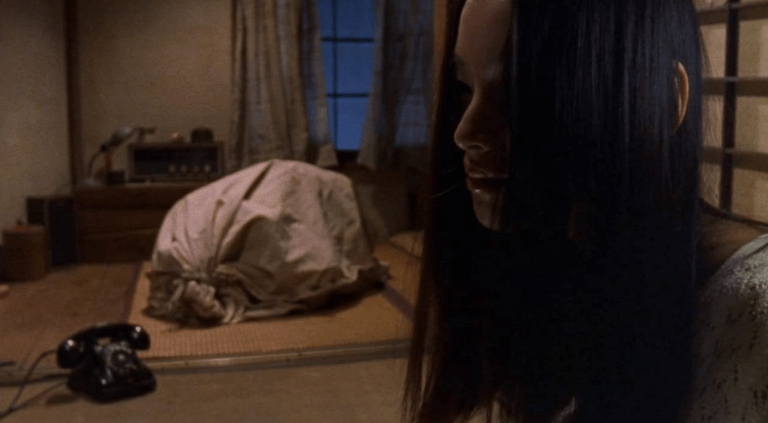
While the ghostly J-horror craze was beginning to kick off around the world, master genre filmmaker Takashi Miike unleashed a different kind of horror movie onto an unsuspecting audience. For much of its run time, Audition is a psychological horror movies about a man, Aoyama (Ryo Ishibashi), who becomes romantically interested in a mysterious woman, Asami (Eihi Shiina), who has dark, obsessive secrets. The tortuous finale of the movie is what everyone really remembers though. As gruesome as the movie’s final scenes are though, Audition may not be as extreme as other movies on this list. However, Audition earns a spot on this list for being the most high-profile film that general audiences point to when talking about disturbing movies from Japan.
Visitor Q (2001)

Filmmaker Takashi Miike has tons of great movies, but he hit a stride in the late 1990s and early 2000s in which the world became absolutely fascinated with his films. Visitor Q is one of the wildest movies to come out of that era for the director. The focus of the film is on a supremely messed-up family. To start off, the father has sex with his teenage prostitute daughter, and the son viciously abuses his drug-addicted mother. Then one day, a mysterious man known as Q begins to live with the family after hitting the father in the head with a rock. It’s difficult to explain, but somehow Q’s presence brings the family together after beatings, multiple murders, necrophilia, and a shower of breast milk.
Ichi the Killer (2001)

In a big way, Takashi Miike helped bridge the gap between the mean-spirited extreme horror movies of the 80s and 90s and the sillier, more fun extreme movies of the 2000s and beyond. Ichi the Killer is the best example of this bridge. It is a yakuza crime movie that builds up to a battle between the sexually repressed and violent “hero” of the story, Ichi (Nao Omori), and Kakihara (Tadanobu Asano), the merciless yakuza enforcer with a scarred face and cut-up mouth who features prominently on all of the movie’s advertising. Before their climactic fight, audiences are treated to wild action, extreme cruelty, self-mutilation, horrific sexual violence, and plenty of murder and dismemberment. As messed-up as the movie is at times, it also carries with it a ridiculousness that makes it partly a black comedy.
New Wave of Extreme Japanese Horror • 2005 – 2022
Meatball Machine (2005)
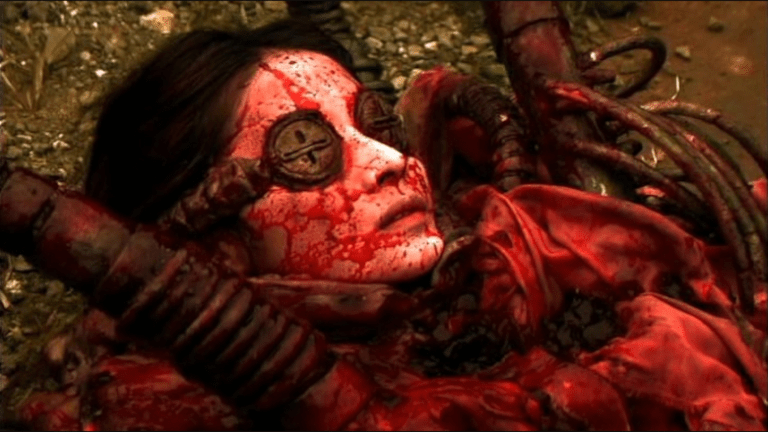
Meatball Machine signaled the beginning of a new wave of over-the-top movies that combine gore, body horror, action, sci-fi, comedy, and just about every other genre you can think of. At its core, Meatball Machine is a Japanese cyberpunk splatter movie. A young, lonely man named Yoji (Issei Takahashi) finds an alien parasite one night. After the parasite transforms the woman he has a crush on into one of a number of bio-mechanical monsters called NecroBorgs, Yoji is drawn into a world of monstrous battles where the losing NecroBorg ends up as a bloody pile of flesh and machinery. Despite its popularity, it took more than a decade for Meatball Machine to get a sequel with Meatball Machine: Kodoku (2017)
X-Cross (2007)
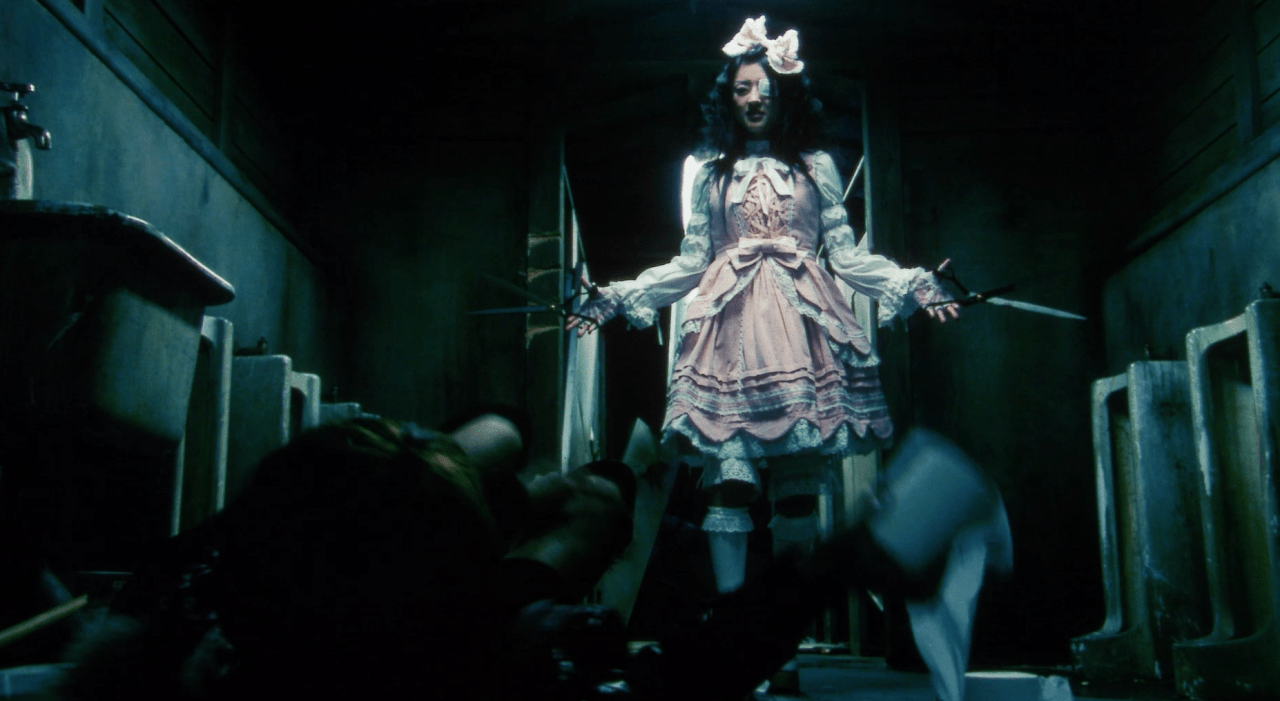
Folk horror is the focus of the well-made and intriguing movie X-Cross (also stylized as XX). Shiyori (Nao Matsushita) and Aiko (Ami Suzuki) take a trip to a remote hot springs resort, but they soon discover that the locals have a tradition of chopping women’s legs off so they can’t escape. As Shiyori is chased by the townsfolk, Aiko is separately chased by a murderous woman carrying giant scissors and dressed in a lolita style. It sounds ridiculous and violent (and it is), but there is also a nice mystery underneath the mayhem which is slowly revealed as the audience is alternately shown some of the same scenes from the differing points of view of Shiyori and Aiko.
The Machine Girl (2008)
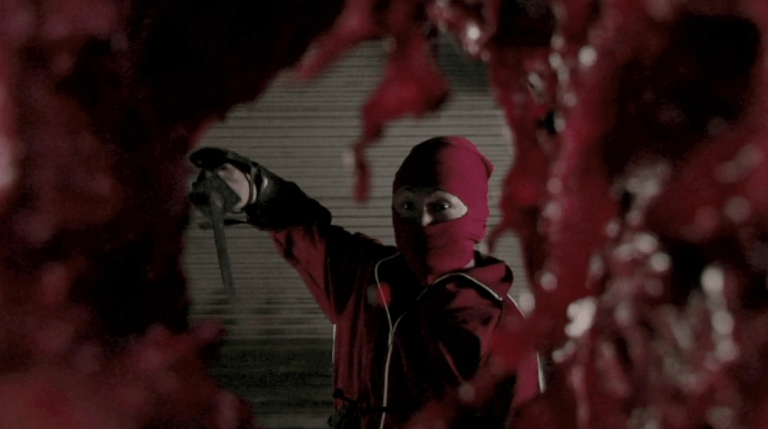
The Machine Girl is a revenge movie amped up to ludicrous extremes thanks to yakuza, ninja, and a one-armed schoolgirl with a multi-barreled machine gun attached to her arm stump. Minase Yashiro stars as a schoolgirl named Ami whose brother is killed by bullies. Ami’s quest for revenge results in her losing an arm, but that only makes her more dangerous. Body parts go flying and numerous blood fountains erupt as Ami and her enemies try to outdo each other until there is no one left to kill.
Tokyo Gore Police (2008)
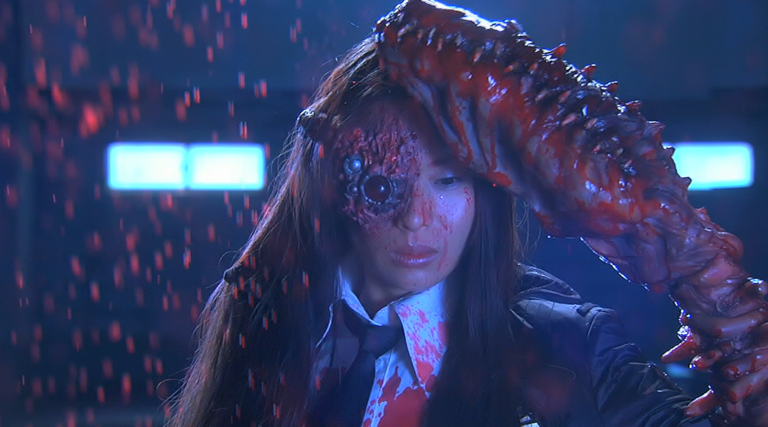
Tokyo Gore Police is likely the most recognizable movie to come out of the 2000’s cycle of Japanese splatter comedies, and there are plenty of good reasons for that. The best reason is that Tokyo Gore Police is one of the better-made gore movies of its time. The movie follows Ruka (Eihi Shiina), a star police officer who excels in hunting and killing “Engineers.” An Engineer is a mutated human whose body organically grows weapons from the spot of any injury they suffer. For example, the opening scene shows the privatized police force of the movie chopping off an Engineer’s arm, only to have the criminal grow a chainsaw from his stump. As you might imagine, the battles get extremely crazy.
Grotesque (2009)
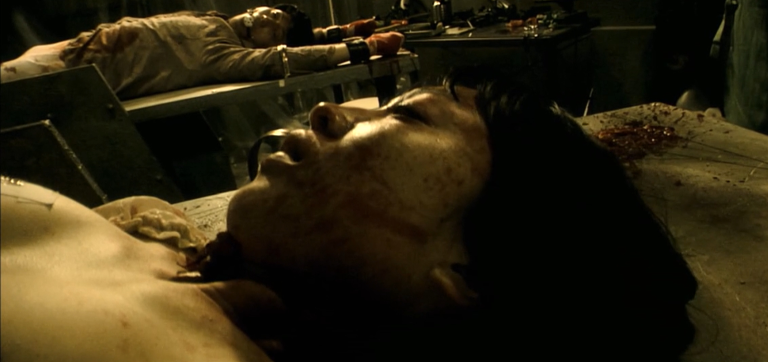
Grotesque is a movie that is best categorized along with the cycle of “torture porn” movies in the mid-2000s like Saw (2004) and Hostel (2005). The film is about a young couple who are kidnapped, tortured, and sexually assaulted by an unnamed man. The movie has little in the way of characterization or plot, so it essentially a grueling experience of torture for both the characters and the audience. Grotesque has none of the comedy that many of the other splatter movies released around the same time did, and at the time of its release it did provide a good alternative for horror fans looking for something more bleak and brutal.
RoboGeisha (2009)

RoboGeisha is one of the more ridiculous entries in the wave of mid-2000s Japanese shock cinema. Yoshie (Aya Kigushi), the abused sister of a popular geisha, finds her calling as an assassin for a mysterious corporation. To enhance her lethality, Yoshie’s body is gradually transformed with numerous cybernetic implants that give her various weapons and abilities such as hair cannons, swords that come out of her armpits and butt, and having her lower body transform into a tank. RoboGeisha isn’t nearly as gory as a lot of the other movies it’s associated with, and it gets a lot sillier than those other films, but it’s still a blast for fans of wacky Japanese cinema.
Vampire Girl vs Frankenstein Girl (2009)
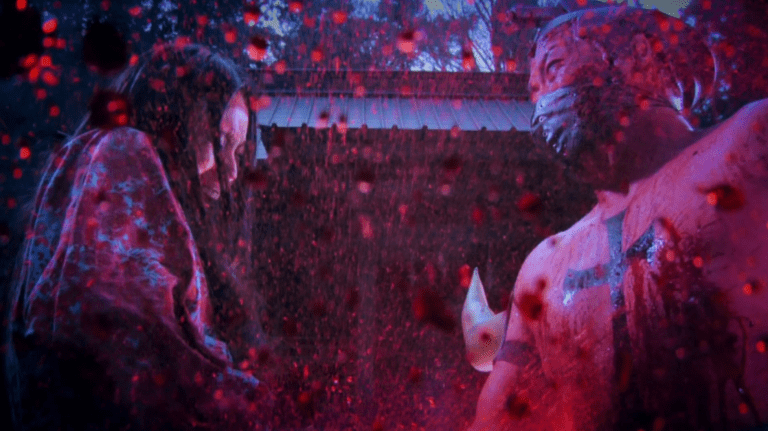
A love triangle forms the foundation for a goofy and gory battle between a vampire and a reanimated corpse in Vampire Girl vs. Frankenstein Girl. High-school boy Mizushima (Takumi Saito) is reluctantly dating Keiko (Eri Otoguro), the daughter of a mad scientist, but the vampiric Monami (Yukie Kawamura) has a crush on Mizushima. Monami makes her move on Valentine’s Day, giving Mizushima a blood-laced chocolate that turns him into a half-vampire. Keiko fights for her boyfriend, but after she dies by falling off the school roof, she is brought back as a Frankenstein’s monster. Then the real battle begins.
Lust of the Dead (2012)
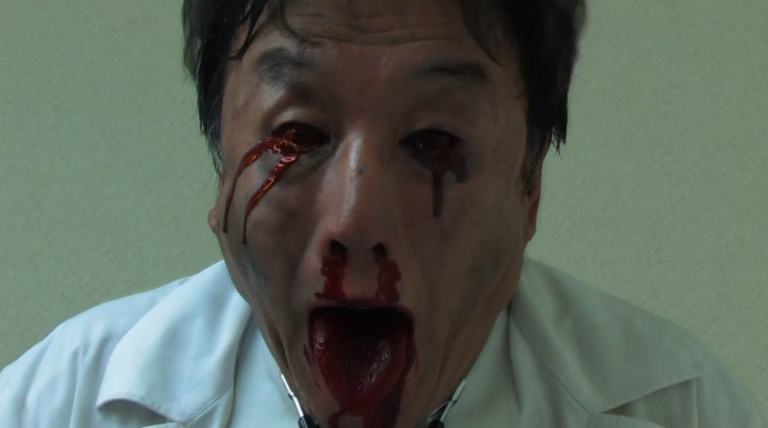
Lust of the Dead is an atrocious movie. The original, full title of the movie is Rape Zombie: Lust of the Dead, and the title says it all. This movie is about a virus that turns most men into zombies who violently rape women, usually killing their victims in the process. The survivors of the initial outbreak fight back against the rampaging rapists in different ways, which essentially leads to a bunch of scenes with nudity, gore, and gross zombie sex. Lust of the Dead is one of those movies that seems like it’s pushing boundaries just to be as edgy as possible.
Mai-chan’s Daily Life: The Movie (2014)

Based on the incredibly transgressive manga of the same name created by Waita Uziga, Mai-chan’s Daily Life tells the story of a maid who cannot die. Mai-chan (Koshi Ann) has the ability to heal from injuries that would kill anyone else, and she can even regrow body parts. Mai-chan’s master takes pleasure torturing her to grotesque extremes, and a new maid in the house, Miyako (Miyako Akane), soon discovers that she enjoys torturing (and eating) Mai-chan as well. Mai-chan’s Daily Life is an extremely low-budget effort that isn’t particularly well-made, but it does feature some disturbingly memorable sequences. Anyone expecting a direct adaptation of the manga will be disappointed though. For others, it may come as a relief knowing that certain parts of the manga didn’t make it onto the screen.
Brutal (2017)

Romance (sort of) blossoms in Brutal, a movie about two sexually motivated serial killers. The story is told in three parts. The first chapter introduces viewers to a male killer who collects women’s body parts after luring them to his apartment and murdering them in rage-fueled outbursts. Chapter two introduces a female killer who gets men alone and kills them mostly by stabbing them repeatedly in their crotch. The final chapter shows what happens when these two killers meet and discover that they may fill the voids in each other’s lives with more than just numerous stab wounds (although yes, there is a lot of stabbing).
More Shocking Movies from Japan

- Jigoku (1960) – Also known as The Sinners of Hell, Jigoku marked a shift towards more overt graphic violence in Japanese horror movies.
- Shogun’s Joy of Torture (1968) – Terui Ishii’s seminal torture film consists of three stories of crime and brutal punishment from Japan’s history.
- The Joy of Torture 2: Oxen Split Torturing (1976) – Also known as Shogun’s Sadism, this anthology of two shorts depicts rape, torture, and murder set in Japan’s Edo period.
- 964 Pinocchio (1991) – Shozin Fukui directs this bonkers flick about a sentient cyborg sex doll thrown out because he can’t perform his one duty.
- Women’s Flesh: My Red Guts (1999) – This rather poorly-made gore movie is notable for its extreme depiction of self-mutilation in two plotless scenarios.
- Celluloid Nightmares (1999) – A female reporter is drawn into a dark world as she investigates a snuff film.
- Orozco the Embalmer (2001) – Made by Japanese filmmaker Kiyotaka Tsurisaki, this documentary shows numerous graphic depictions of dead bodies as it follows Colombian embalmer Froilan Orozco.
- Suicide Club (2001) – Also known as Suicide Circle, this is a bizarre movie that became notorious for its gory scene of 54 schoolgirls simultaneously committing suicide by jumping in front of a speeding train.
- Gozu (2003) – Takashi Miike’s Gozu is an impossible-to-describe yakuza movie with some truly bizarre scenarios.
- Strange Circus (2005) – An author writes a story of incest and rape that blends fantasy and reality in this mind-bending movies from Sion Sono.
- Cold Fish (2010) – This movie about two fish shop owners may be Sion Sono’s darkest and most extreme movie.
- Corpse Prison 1 & 2 (2017) – A remote village where no women have been born in 50 years is the setting for this cheap and trashy shocker based on the manga of the same name.